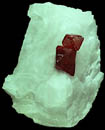|
|
| Formula: | MgAl2O4 |  Click to see a larger image |
||
| Crystal: | Isometric | |||
| Hardness: | 7.5-8 | |||
| Spec. Gr.: | 3.58-4.6 | |||
| Streak: | White | |||
| Cleavage: | None | |||
| Location: | Mogok, Myanmar |
| Spinel is a hard (H 7.5-8), transparent to translucent mineral, usually occurring in octahedral shaped crystals. Its colors vary with composition from white to red, blue, violet, yellow, brown, blue-green, and black. The so-called "ruby spinel" has a blood-red color. Large fine spinels are very rare and are costly. Only the fact that spinels are not well known, except to the trade, keeps smaller stones from fetching their real value. Many of the world's large rubies, some of which are set in royal regalia, are in fact, spinels. A prime example is the Black Prince's Ruby, an enormous fiery deep red stone that is two inches across, and which is set in the front of the Imperial State Crown of England. First known in 1367, it has had a great history as probably the world's finest ruby. Only recently, tests showed it to be a red spinel. The most notable localities for gem spinel are: the gem gravels of Sri Lanka (formerly Ceylon); gem mines in Afghanistan, Thailand, Cambodia, and Pereval, Baikal, Russia; and especially the mines at Mogok and Mong Hsu in Myanmar (formerly Burma). |
|
Bibliography: Arem, Joel, Gems, 1975, pg. 111-112. Bancroft, Peter, Gem and Crystal Treasures, 1984, pg. 268-271. |
|
University of California, Santa Barbara—Department of Earth Science Copyright © 2005 Regents of the University of California Send your comments to the Web Page Editor |